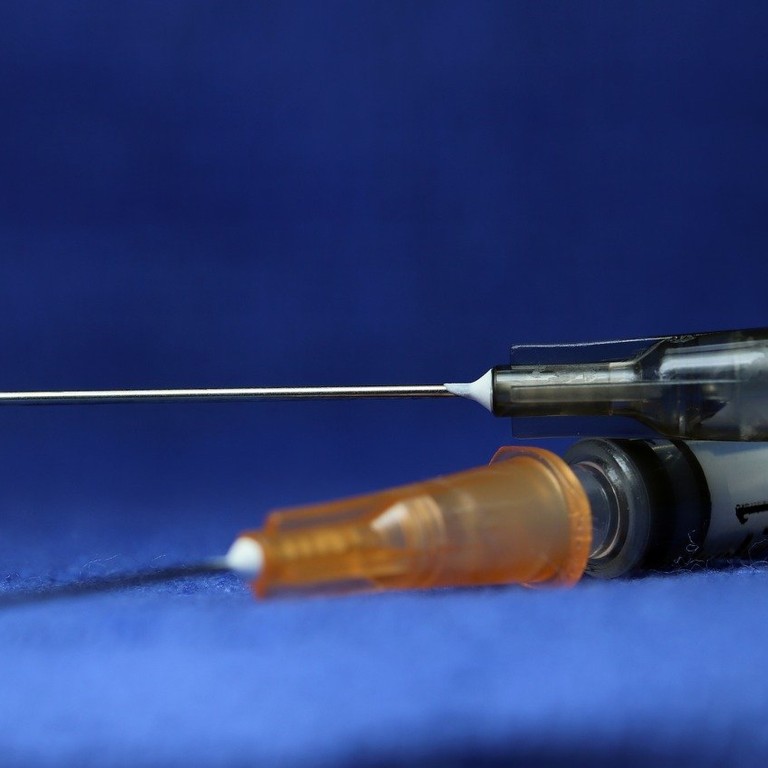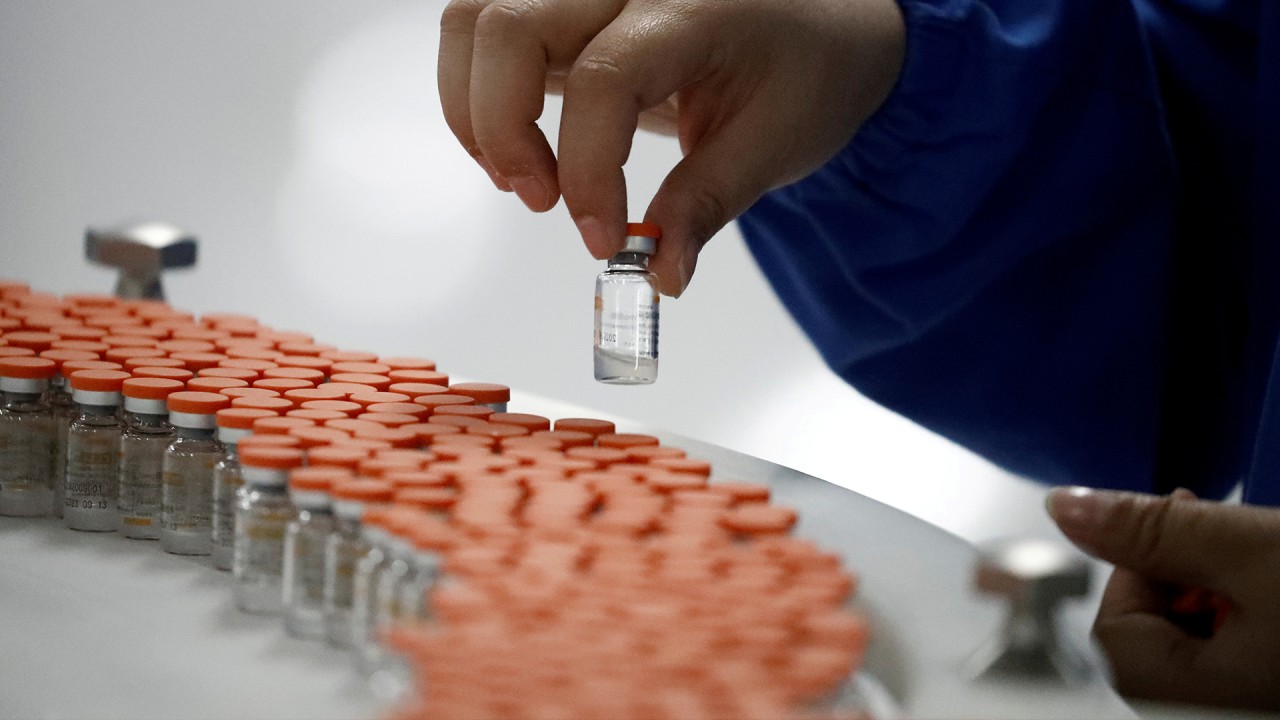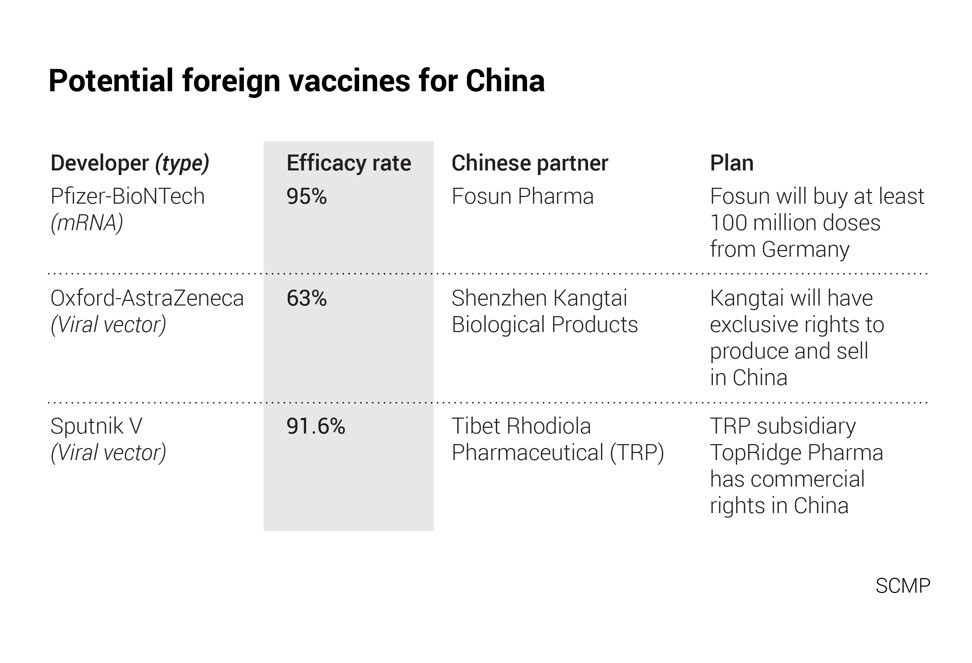
China’s production bottleneck ‘could be eased with latest Covid-19 vaccine’
- Emergency use approval paves way for large-scale manufacture of cheap, easy-to-produce vaccines but three doses required
- Non-peer reviewed clinical trial data suggests vaccine is well tolerated and produces immune response against the virus
China can meet coronavirus vaccine demand ‘at home and abroad’
No interim results for the final stage clinical trials – involving 29,000 people – have been released but non-peer reviewed data from phase 1 and 2 trials found the vaccine, jointly developed by Anhui Zhifei Longcom Biopharmaceutical and the Chinese Academy of Sciences’ Institute of Microbiology, to be “well-tolerated and immunogenic”.
The same data, published in December on the preprint server medRxiv.org, showed no serious adverse events related to the vaccine, and indicated that neutralising antibodies were detected in 97 per cent of participants in a group receiving 25 microgram doses in phase 2 trials.
China’s regulatory authority, the National Medical Products Administration, granted similar emergency use approvals (EUAs) based on phase 1 and 2 trial data to three inactivated vaccines in July last year. A fourth vaccine was approved by the military’s drug regulatory authority in China.
Zhifei’s ZF2001, a protein subunit vaccine, is the first of its kind to be approved in the world for use against the Covid-19 virus. The technique has been widely used in vaccines for hepatitis B, whooping cough and flu and is considered very safe.
It was developed by Gao Fu – who also heads the Chinese Centre for Disease Control and Prevention – and his fellow researchers Yan Jinghua and Dai Lianpan at the Chinese Academy of Sciences, based on their previous research on another coronavirus that causes the Middle East Respiratory Syndrome (Mers).
More countries halt AstraZeneca as WHO says vaccine safe
A small fragment of the new coronavirus spike protein – called the receptor-binding domain – equips the body’s immune system to recognise future infections. But while the fact it contains only a small part of the virus makes side effects less likely, the technique also means long-lasting immunity is harder to achieve. Chemicals, called adjuvants, are added to elicit a stronger immune response and booster shots are often required.
In the case of ZF2001, three doses are recommended, at 30 days apart, compared to Covid-19 vaccines from Johnson & Johnson and CanSino which require a single shot.
According to industry experts, production for this kind of vaccine is stable and reliable, and easier to achieve large-scale industrial production at home and overseas. It can also be stored and transported at 2-8 degrees Celsius, making it potentially more suitable in countries where specialised storage and distribution facilities may be limited.
Nikolai Petrovsky, professor of medicine at Flinders University in Australia and secretary general of the International Immunomics Society, said Chinese companies had largely focused on traditional technologies, such as inactivated viruses, to develop Covid-19 vaccines.

02:07
China relaxes visa rules for foreigners inoculated with Chinese-made vaccines
“We still don’t know which technology will prove superior to protect against Covid-19 in the long run, so in the meantime it will be beneficial to have many different technologies available so that these can be compared. The winner will be the technology that not only provides the highest short and long-term protection, [but also] gives the best protection against emerging viral variants, and has strong tolerability and safety,” he said.
“Very little peer-reviewed data has been published on the performance of Chinese vaccines, so this can make it hard to assess their performance against vaccines developed elsewhere.”
According to Yanzhong Huang, senior fellow for global health at the Council on Foreign Relations in the US, the decision to grant emergency approval for the new vaccine could be for practical reasons, to add another source for supplies.
“China’s drug regulator allows this to happen and clearly it’s not unprecedented,” he said.
“One of the reasons an EUA is issued is that it allows the scaling up of production, when there is a production capacity restraint they are facing.”
Huang added that Zhifei’s vaccine – which does not require a high biosafety level facility – could ease China’s production bottleneck.
“It can be very inconvenient for people to come back for a second and third dose. It requires a lot of logistic support and kind of discouraging,” he said.
More China Covid-19 vaccines out for delivery as world scrambles for shots
But Shanghai vaccine expert Tao Lina said it was common for subunit protein vaccines to be given in three doses – as with the vaccines against hepatitis B and human papillomavirus (HPV) – and they were still easier to produce and cheaper than the inactivated variety.
“The vaccine has its advantage of being safe, easier for large-scale production and cheap. When the government is paying for Covid-19 vaccines, the price advantage can’t be omitted,” he said.
“Covid-19 is not prevalent in China and the EUA allows the vaccine to be administered among the general public. We have a good time window for administering the vaccine even though it takes two months to finish the regimen.”
Speaking in his capacity as head of China’s CDC earlier this month, Gao said China’s goal to have up to 80 per cent of its population inoculated against the virus could be achieved by the middle of next year.
Pu Jiang, general manager of Zhifei Longcom, said on Anhui Television in February that his company had an annual production capacity of 1 billion doses and estimated the vaccine could be launched for general use in the first half of this year.
In Uzbekistan, the first country to start phase 3 trials of the Zhifei vaccine with 7,000 participants, by early March all had received the first dose, more than 4,400 had been given the second dose, while the third had been administered to 300 people, according to a report at People.com.cn.
The vaccine also appeared to be working well against the B.1.351 variant, first detected in South Africa, according to another small-scale, but not peer reviewed, study published by preprint server bioRxiv.org. Researchers found the vaccine largely preserved neutralising levels of antibodies in the blood, with only a slight reduction.
Additional reporting by Holly Chik




